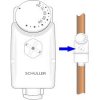- Joined
- 8 Jun 2017
- Messages
- 7
- Reaction score
- 1
- Country

I would like to replace my existing Honeywell Froststat and Danfoss TP1 that has Cosy Smart Thermostat installed alongside it (Danfoss always on and Cosy does the controlling)
I want to replace with a Hive v1 and it looks straight forward enough just getting a little confused with the numbering of the wires in each system.
I have attached a photo of the current setup, if you need any photos of the wiring of the Cosy let me know and I'll get some uploaded.
I want to replace with a Hive v1 and it looks straight forward enough just getting a little confused with the numbering of the wires in each system.
I have attached a photo of the current setup, if you need any photos of the wiring of the Cosy let me know and I'll get some uploaded.




